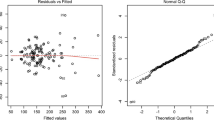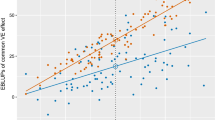Summary
Incomplete block designs for a complete diallel cross (CDC) experiment known as method (2) of Griffing (1956) are proposed. These designs are derived by using mutually orthogonal Latin squares of order p, when p is a prime integer or power of a prime integer. With p inbred lines, the [p(p + 1)/2 − 1] degrees of freedom, for this method of Griffing, are partitioned into two orthogonal sets of (p − 1) and p(p − 1)/2 degrees of freedom the former for general combining ability (g c a) and the latter for specific combining ability (s c a) effects, respectively. These designs are optimal in the sense of Kempthorne (1956). The analysis includes the analysis of variance and the estimation of general combining ability and of specific combining ability. The analysis is illustrated numerically.
Similar content being viewed by others
References
Aggarwal, K. R. (1974) Analysis of Li(s) and triangular designs, Journal of the Indian Society for Agricultural Statistics, 26, 3–13.
Agarwal, S. C. and Das, M. N. (1987) A note on construction and application of balanced n-ary designs, Sankhya, Vol. 49, Ser. B, pt 2, 192–196.
Agarwal, S. C. and Das, M. N. (1990) Use of n-ary block designs in diallel crosses evaluation, Journal of applied statistics, Vol. 17, n. 1, 125–131.
Bose, R. C., Shrikahande, S. S. and Parker, E. T. (1960) Further results on the construction of mutually orthogonal Latin squares and falsity of Euler’s Conjecture, Can. J. Math., 12, 189.
Baraaten, O. B. (1965) The union of partial diallel mating designs and incomplete block environmental designs, Dissertation, North Carolina State University.
Ceranka, B. and Mejza, S. (1988) Analysis of diallel table for experiments carried out in BIB design mixed model, Biometrical Journal, 30, 3–16.
Chai, F. S. and Mukerjee, R. (1999) Optimal design for diallel crosses with specific combining abilities, Biometrika, 86(2), 453–458.
Das, A., Dey, A. and Dean, A. (1998) Optimal design for diallel cross experiments, Statist., Prob. Letters, 36, 427–436.
Dey, A. (1986) Theory of block designs, Wiley Eastern, New Delhi.
Dey, A. and Midha, Chand, K. (1996) Optimal designs for diallel crosses, Biometrika, 83(2), 484–489.
Divecha, J. and Ghosh, D. K. (1994) Incomplete block designs for complete diallel crosses and their analysis, Journal of Applied Statistics, Vol. 21, n. 5, 49–62.
Gupta, S. and Kageyama, S. (1994) Optimal complete diallel crosses, Biometrika, 81,420–424.
Fisher, R. A. and Yates, F. (1963) Statistical tables for biological, agricultural and medical research, Oliver and Boyd, Edinburg.
Griffing, B. (1956) Concept of general specific combining ability in relation to diallel crossing systems, Aust. J. Biol. Sci, 9, 463–93.
Hallauer, A. R. and Miranda, J. B. (1988) Quantitative genetics in maize breeding, 2nd ed. Ames, IA: Iowa State University Press.
Kempthorne, O. (1956) The theory of diallel crosses, Genetics, 41, 451–459.
Kempthrone, O. and Curnow, R. N. (1961) The partial diallel cross, Biometrics, 17,229–250. [See also correction, Biometrics 18 (1962), 128].
Mukerjee, R. (1997) Optimal partial diallel crosses, Biometrika, 84(4), 937–946.
Parsad, R., Gupta, V. K. and Srivastava, R. (1999) Optimal designs for diallel crosses, Jour. Soc. Stat., Comp. and Application, 1, 35–52.
Raghavarao, D. (1971) Constuction and combinatorial problems in design of experiments, J. Wiley and Sons, New York.
Rao, C. R. (1973) Linear statistical inference and its applications, 2nd edition.J.Wiley and Sons, New York.
Sharma, M. K. (1996) Blocking of complete diallel crossing plans using balanced lattice designs, Sankhya B., 58(3), 427–430.
Sharma, M. K. (2004) Optimal complete diallel cross, advances in mating designs (Chapter 15), Dhanpat Rai &Co. (P)Ltd., N. Delhi.
Sharma, M. K. and Fanta, Sileshi (2009) Incomplete block designs for CDC method I and III, Metron, Vol. LXVII, n.2, 209–226.
Sharma, M. K. and Fanta, Sileshi (2010) Optimal block designs for diallel crosses, Metrika, 71, 361–372.
Sharma, R. J. (1998) Statistical and biometrical techniques inplant Breeding, New Age International Publication (p) Limited, Publishers, New Delhi.
Singh, M. and Hinkelmann, K. (1998) analysis of partial diallel crosses in incomplete blocks, Biometrical Journal, 40, 165–181.
Tocher, K. D. (1952) The design and analysis of block experiments (with discussion), J. Royal Statist. Soc., B, 14, 45–100.
Author information
Authors and Affiliations
Corresponding author
Rights and permissions
About this article
Cite this article
Sharma, M.K., Melesse, S.F. Optimal block designs for CDC experiments method (2). METRON 69, 297–307 (2011). https://doi.org/10.1007/BF03263563
Received:
Revised:
Published:
Issue Date:
DOI: https://doi.org/10.1007/BF03263563




